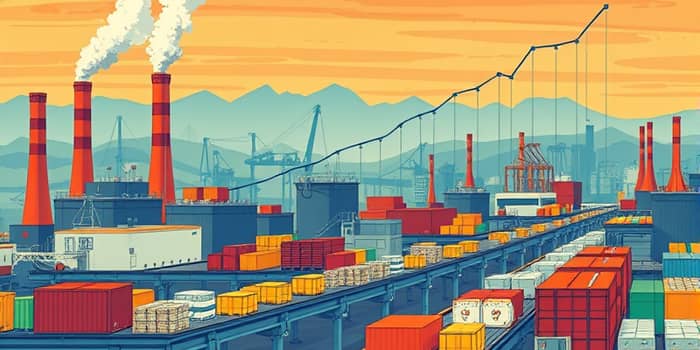
The Producer Price Index (PPI) is a cornerstone of economic analysis, offering a window into the wholesale price movements that precede shifts in consumer costs. By examining price trends at the producer level, businesses, policymakers, and analysts gain a powerful gauge of inflation long before retail prices adjust. Understanding the PPI empowers decision-makers to anticipate market dynamics, adjust strategies, and foster resilient economic growth.
In this article, we delve into the origins, mechanics, and applications of the PPI. You’ll learn how it’s calculated, the industries it covers, and why it matters for forecasting and policy. Our goal is to provide both inspiration and practical guidance, ensuring you can leverage PPI insights for informed choices.
The PPI measures the average change over time in the selling prices received by domestic producers for their output. Unlike the Consumer Price Index (CPI), which focuses on prices paid by households, the PPI captures price fluctuations at the source—by producers and wholesalers.
As a leading indicator for changes in consumer inflation, the PPI is closely watched by central banks and economists. When producer prices rise sharply, it often signals that consumer prices will follow suit, albeit with a lag. This makes the PPI indispensable for economic forecasting and policy formulation.
Originating in an 1891 Senate resolution, the PPI is one of the oldest continuous statistical series in the United States. Known initially as the Wholesale Price Index (WPI), it was rebranded as the PPI in 1978 to better reflect its broader scope across goods and services.
Today, the U.S. Bureau of Labor Statistics (BLS) publishes over 10,000 individual PPIs each month, based on more than 64,000 price quotations. The index covers:
This extensive coverage ensures that the PPI delivers a comprehensive snapshot of wholesale price movements, spanning raw materials to finished goods.
The PPI tracks price changes at multiple stages of production. It captures three broad categories:
By organizing data across these stages, analysts can identify where inflationary pressures are mounting—whether at the extraction of raw commodities or in the assembly of finished products. This granular insight aids businesses in adjusting procurement and pricing strategies.
While both the PPI and CPI measure inflation, they do so from distinct vantage points. The PPI focuses on prices received by sellers, excluding taxes, transport, and retail markups, whereas the CPI covers final costs borne by consumers.
The basic PPI formula is straightforward:
PPI = (Current Price of Basket of Goods / Base Price of Basket of Goods) × 100
By setting the base year index at 100 (December 1982 in the U.S.), any value above 100 indicates a price increase since that base period. For example, if July 2023 prices average $120 against a base of $100 (January 2022), the PPI equals 120—denoting a 20% rise.
Beyond the simple index, the BLS employs specialized measures:
Laspeyres Index uses base year quantities to weight prices, while the Paasche Index applies current-period quantities. The Fisher Formula—the geometric mean of Laspeyres and Paasche—provides a balanced perspective between past and present consumption patterns.
The PPI spans every major segment of the economy, including mining, manufacturing, services, and construction. It draws on over 64,000 price quotes to produce:
With such extensive sampling, the index reflects the true breadth of wholesale market activity, from steel and semiconductors to hospitality services and building projects.
Each month, the BLS gathers data through representative surveys, sampling large firms and small businesses alike. The rigorous methodology ensures that the index remains current and accurate, capturing seasonal adjustments and regional variations.
Governments rely on the PPI to guide monetary policy, adjusting interest rates to temper inflation before it fully emerges in consumer prices. Corporations embed PPI clauses in long-term contracts to protect against cost fluctuations, while analysts use PPI trends to anticipate shifts in profit margins and consumer spending.
As of May 2025, prices for processed goods at the intermediate stage rose by 0.1% following a 0.3% gain in April. These incremental shifts, reported monthly by the BLS, offer a nuanced view of evolving cost pressures across industries.
Companies in energy-intensive sectors, for instance, have felt sharper input cost increases, prompting adjustments in pricing strategies and operational efficiencies.
Global counterparts mirror the U.S. approach, though methodologies vary. Some nations, like India, historically used a Wholesale Price Index before transitioning emphasis toward the CPI for headline inflation. Comparing PPIs internationally reveals differences in industrial structures and regulatory environments.
Despite its strengths, the PPI has constraints. It excludes certain non-price factors—such as service quality—and may lag in capturing rapid market disruptions. Additionally, its focus on domestic producers can omit crucial imported input costs in global supply chains.
By tracking wholesale price changes, the Producer Price Index offers an early warning system for inflationary pressures, empowering stakeholders to act with foresight. Whether you’re a policymaker crafting interest rate decisions or a business leader negotiating contracts, mastering the PPI framework equips you with the insights needed to navigate an ever-changing economic landscape.
Embrace the PPI as a strategic tool, and let its revelations guide you toward stronger, more resilient outcomes in both policy and commerce.
References













